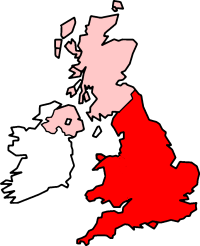England and Wales (red), with the rest of the United Kingdom (pink).Westminster Cathedral, considered the Catholic mother church of England and Wales. A diocese , also known as a bishopric, is an administrative unit under the supervision of a bishop , of which there are currently 22 in the Catholic Church in England and Wales . The 22 dioceses are divided into five ecclesiastical provinces , each being overseen by an archbishop . The archdiocese of Westminster is considered the mother church of English and Welsh Catholics,[ 1] primate , the archbishop of Westminster is usually elected President of the Catholic Bishops' Conference of England and Wales providing a degree of a formal direction for the other English bishops and archbishops.
From the time of the English Reformation in the 16th Century, with Catholicism becoming illegal, there were no Roman Catholic dioceses in England and Wales, with several apostolic vicars , bishops of titular sees governing not in their own name, as diocesan bishops do, but provisionally in the name of the Pope , being appointed instead. However, with the passing of the Catholic Relief Act 1829 , legalising the practice of the Catholic faith again, Pope Pius IX recreated the Catholic Church diocesan hierarchy on 29 September 1850 by issuing the papal bull , Universalis Ecclesiae
Two Catholic dioceses, those of Leeds and Portsmouth, share their territorial name with Anglican dioceses , the Anglican Diocese of Leeds and the Anglican Diocese of Portsmouth , respectively. However, in both these cases the two dioceses cover differing areas.
Episcopal Conference of England and Wales
Ecclesiastical province of Birmingham
Ecclesiastical province of Cardiff
Ecclesiastical province of Liverpool
Ecclesiastical province of Southwark
Ecclesiastical province of Westminster
Other
The Ukrainian Greek Catholic Church in Britain is organised into Ukrainian Catholic Eparchy of Holy Family of London , headed by a bishop. The Eastern Catholic Churches , including the Ukrainian Greek Church, are autonomous, self-governing particular churches in full communion with the Pope .
The Personal Ordinariate of Our Lady of Walsingham is one of three Personal Ordinariates . The ordinariates were established in order to enable "groups of Anglicans"[ 9] Ordinaries .
See also
References
^ "Westminster" . The Catholic Church in England and Wales. Retrieved 20 April 2014 .^ "Menevia" . The Catholic Church in England and Wales. Retrieved 21 April 2014 .^ "Hallam" . The Catholic Church in England and Wales. Retrieved 21 April 2014 .^ "Arundel and Brighton" . The Catholic Church in England and Wales. Retrieved 21 April 2014 .^ "Plymouth" . The Catholic Church in England and Wales. Retrieved 21 April 2014 .^ "Brentwood" . The Catholic Church in England and Wales. Retrieved 21 April 2014 .^ "East Anglia" . The Catholic Church in England and Wales. Retrieved 21 April 2014 .^ "Nottingham" . The Catholic Church in England and Wales. Retrieved 21 April 2014 .^ Note: The Latin title of Anglicanorum Coetibus means "Groups of Anglicans".
^ "Rt Rev Hlib Lonchyna" . The Catholic Church in England and Wales. Retrieved 21 April 2014 .^ "Personal Ordinariate of Our Lady of Walsingham" . The Catholic Church in England and Wales. Retrieved 21 April 2014 .
External links








